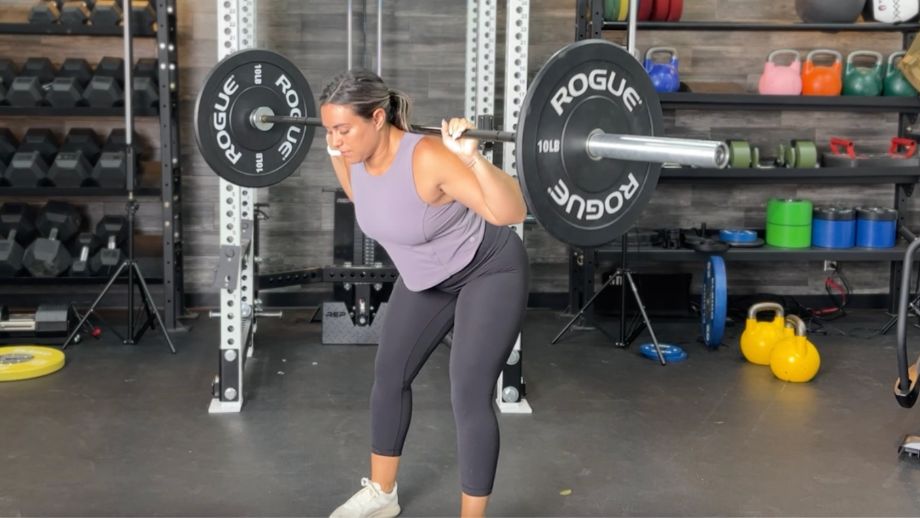We test and review fitness products based on an independent, multi-point methodology. If you use our links to purchase something, we may earn a commission. Read our disclosures.
Including posterior chain exercises in your workout routine is important for several reasons. A thick and well-developed back, as well as powerful glutes and hamstrings, are aesthetically pleasing. You may notice a reduction in lower back pain, especially if you’re a beginner to resistance training. As a result of increasing your posterior chain strength, your anterior chain lifts may improve.
Based on my 10 years of experience in weight training—both as an enthusiast and a certified personal trainer—I’ve put together the 13 best posterior chain exercises. I’ll go through each in detail, explaining its benefits and how to do it step-by-step. I’ll then give three posterior chain workouts for you to try and describe the anatomy of the posterior chain.
Let’s get started on building some serious posterior chain muscle.
13 Best Posterior Chain Exercises
- Barbell Bent-Over Row
- Romanian Deadlift
- Good Morning
- Barbell Hip Thrust
- Kettlebell Swing
- Rack Pull
- Glute-Ham Raise
- Pendlay Row
- Cable Pull-Through
- Overhead Carry
- Single-Leg RDL
- Pull-Up
- Lunge
Barbell Bent-Over Row
Muscles worked: Latissimus dorsi, rhomboids, trapezius, posterior deltoids, hamstrings, lower back, glutes, biceps, core
Benefits: The unique benefit of barbell rows is that they activate the upper and lower-body posterior chain muscles. Because they hit your full body, you can add more weight to the bar while improving your grip strength.
How to Do it:
- Place a barbell on the floor, and add the necessary weight plates.
- Step underneath the bar. You’ll want your feet shoulder-width apart and the bar covering your shoelaces.
- Squat down and grasp the bar with an overhand grip (palms facing the floor).
- Brace your core, then deadlift the barbell to your pelvic region.
- Bend your knees slightly and drive your hips backward so your torso is bent. The bar should be near your shins.
- Row the bar toward your abdominal region, ensuring that your elbows are tucked into your body.
- Hold, then reverse the motion to return the barbell to its original position.
- Repeat for repetitions.
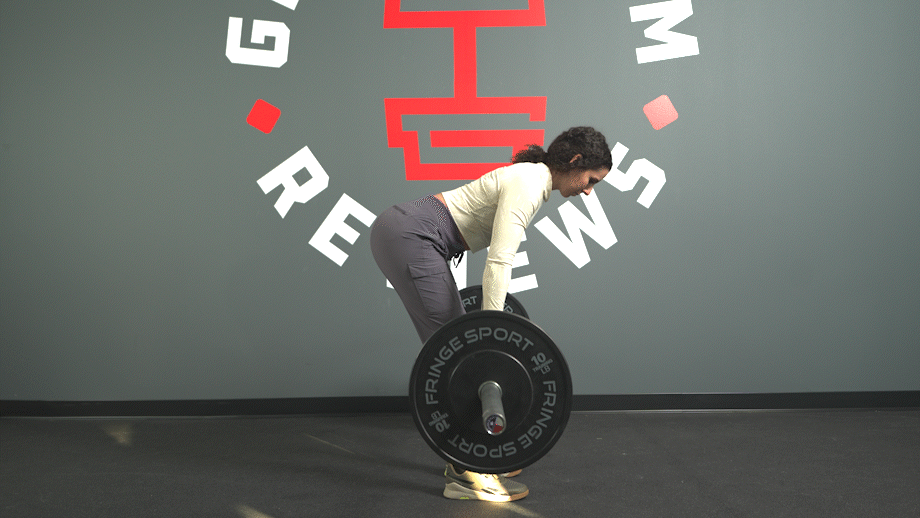
Modifications
- Dial it back: Use a pair of the best dumbbells or kettlebells to learn the bent-over row movement. Both exercises are done with a neutral grip, placing less stress on your wrists than a barbell.
- Make it harder: You can try underhand barbell rows to emphasize your biceps and lower back or wide-grip barbell rows to hit your traps and delts to a greater extent.
Romanian Deadlift
Muscles worked: Hamstrings, lower back, glutes, core
Benefits: Romanian deadlifts are one of the best exercises to activate the hamstring muscles, as shown in a 2014 study by the Journal of Strength and Conditioning Research1 (along with the glute-ham raise, which you’ll see below). I’ve found that compared to conventional deadlifts, Romanian deadlifts place less strain on your lower back and knees.
How to Do it:
- Place a loaded barbell on the ground.
- Step underneath the bar so it covers your shoelaces. Your feet should be hip-width apart.
- Perform a hip hinge and grab the bar with an overhand grip (palms facing the floor).
- Tense your core and deadlift the bar to your pelvic region. This is the starting position.
- Lower the bar towards the floor slowly by pushing your hips back. You’ll want a neutral head position, keeping the bar close to your body throughout.
- Stop when the bar reaches the middle of your shins and pause.
- Drive through your heels to return the bar to the standing position.
- Keep going for reps.
RELATED: Hip Hinge Exercises
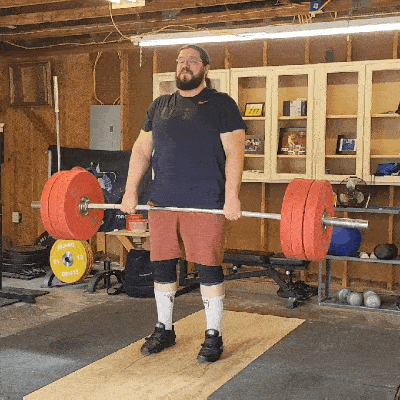
Modifications
- Dial it back: Dumbbell and kettlebell Romanian deadlifts are easier to perform because the equipment starts in your hands instead of needing to deadlift it to the starting position. You can also use a resistance band to do banded Romanian deadlifts.
- Make it harder: One alternative is the single-leg RDL, which you’ll see below. These can help to improve balance and stability. You can also perform Romanian deadlifts from a deficit to add an extra challenge or simply increase the load.
Good Morning
Muscles worked: Hamstrings, lower back, glutes, core
Benefits: Regularly doing good mornings will give you two benefits. First, you’ll hit all of the lower body posterior chain muscles. But that’s not all. You’ll also get better at the hip hinge movement, which is helpful for other posterior chain exercises on this list.
How to Do it:
- Adjust the J-hooks on a squat rack or power rack so the barbell is resting at shoulder height.
- Add your preferred weight plates to the bar.
- Step underneath the barbell. You’ll want your hands on either side of the bar and your feet shoulder-width apart.
- Stand up and unrack the bar, then take a couple of steps backward. Adjust your feet if necessary.
- Bend your knees slightly, engage your core, then push your hips back so your chest lowers towards the floor.
- Keep going until your chest is almost parallel to the ground, then pause.
- Drive your hips forward and lift your chest back up with control to return to the starting position.
- Continue for repetitions.
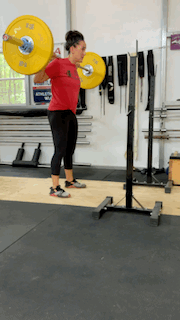
Modifications
- Dial it back: Hold a dumbbell or kettlebell to your chest to learn the movement pattern before progressing to the barbell version. You can also try the exercise with resistance bands by looping one end around your feet and the other around your neck.
- Make it harder: Simply add more load, ensuring that you’re still doing the exercise with the correct form. Single-leg good mornings are another progression, although they will require you to reduce the weight.
RELATED: Best Resistance Bands
Barbell Hip Thrust
Muscles worked: Glutes, hamstrings, lower back, quads, core
Benefits: A 2019 systematic review by the Journal of Sports Science and Medicine2 found that the hip thrust works the gluteus maximus, erector spinae, hamstrings, and quadriceps femoris (in that specific order). As a gluteus maximus exercise, there’s nothing else like it.
How to Do it:
- Load a barbell and place it in front of a flat bench.
- Sit on the ground with your legs extended underneath the bar. Your back should be straight against the bench.
- Roll the bar onto your pelvic region.
- Bend your knees so your feet are flat on the floor. This is the starting position.
- Brace your core, then thrust your hips towards the ceiling by pushing into your heels.
- Continue until there’s a straight line between your upper back and gluteus muscles.
- Squeeze your glutes at the top before slowly returning the bar to the ground.
- Repeat for reps.
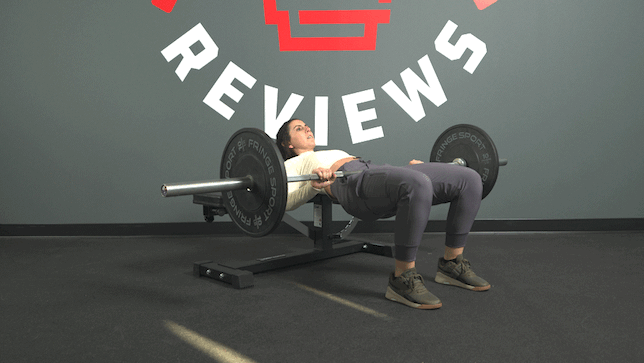
Modifications
- Dial it back: Place a dumbbell, kettlebell, or similar object in your lap to practice the movement. Although I don’t do them myself, I’ve seen many people doing hip thrusts using a Smith machine instead of a barbell.
- Make it harder: Hit each side of the body separately by putting one leg in the air while working the other. This exercise is called single-leg hip thrusts. You can also place your feet on a flat bench (rather than your back) to do feet-elevated hip thrusts.
Kettlebell Swing
Muscles worked: Latissimus dorsi, rhomboids, trapezius, posterior deltoids, hamstrings, lower back, glutes, quads, core
Benefits: Although kettlebell swings usually appear in HIIT workouts, there’s more to them. They activate every muscle group in the posterior chain. A 2013 controlled clinical trial3 by the Journal of Strength and Conditioning Research found that kettlebells may be an effective alternative tool to improve your weightlifting performance, helping with other exercises in the gym.
How to Do it:
- Stand tall with your feet hip-width apart.
- Grab a single kettlebell with an overhand grip (palms facing the floor) and position it at your pelvic region.
- Bend your knees slightly, retract your shoulder blades, and engage your core muscles.
- Push your hips back so your upper body moves toward the ground. The kettlebell should be between your legs.
- Thrust your hips forward, swinging the kettlebell towards the ceiling as you do so.
- Continue until the kettlebell reaches chest height (Russian kettlebell swing) or the overhead position (American kettlebell swing). You’ll want straight arms for both versions.
- Swing the kettlebell back down and allow it to pass between your legs as you hinge your hips.
- Cycle directly into the next rep.
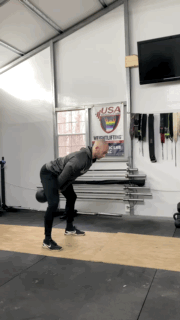
Modifications
- Dial it back: Use a lighter kettlebell to get the hang of it. If you’re still uncomfortable, practice deadlifts and Romanian deadlifts (seen above) using kettlebells first. Both exercises will help to improve your hip extension.
- Make it harder: Progressions to regular kettlebell swings include single-arm kettlebell swings, alternating kettlebell swings, and double kettlebell swings. All three have their pros and cons, so try them to see what works for you.
Rack Pull
Muscles worked: Glutes, hamstrings, lower back, quads, latissimus dorsi, trapezius, core
Benefits: I love rack pulls because you can load the bar heavier than a conventional deadlift while working the same muscle groups. This may lead to hypertrophy benefits in the posterior chain, and you’ll likely improve your deadlift technique, too.
How to Do it:
- Set the rack supports on a squat rack or power rack to just below knee height.
- Place a barbell, and load it with your preferred weight plates.
- Step forward with the tops of your shoelaces underneath the bar, similar to how you would do a traditional deadlift. The bar should be close to your shins, and your feet should be shoulder-width apart.
- Hip hinge to get closer to the barbell, and take hold of it with either an overhand grip (palms facing the floor) or a mixed grip.
- Tense your core before pushing through your heels to lift the bar. You’ll want a neutral head position.
- Stand up and squeeze your glutes at the top of the movement, ensuring the bar stays close to your body.
- Hold momentarily, then slowly drop the bar back down to the rack supports with control.
- Repeat for the desired number of reps.
RELATED: Hypertrophy Workout 101
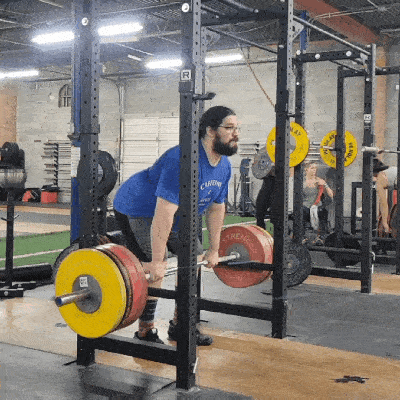
Modifications
- Dial it back: Decrease the range of motion slightly by adjusting the rack supports to sit at or just above your knee height. You can also lower the weight and leave the supports slightly below knee height.
- Make it harder: Try banded rack pulls by wrapping a resistance band underneath the rack and securing it to each end of the barbell. You can also increase your load, perhaps using a pair of the best lifting straps to assist.
Glute-Ham Raise
Muscles worked: Glutes, hamstrings, lower back
Benefits: The glute-ham raise (aka GHR exercise) is a fantastic exercise to activate the hamstrings. It’s also easier to learn because you don’t use a barbell. The risk of getting injured is lower, so beginners may prefer it over other posterior chain exercises.
How to Do it:
- Adjust the glute hamstring developer (GHD) machine so that your feet are firmly pressed against the platform and the back of your ankles are secure underneath the leg rollers. Rest your quads on the middle of the thigh pad.
- Lift your torso so your knees are bent at a 90-degree angle to get into the starting position.
- Squeeze your glutes, stick your chest up, and fold your arms across your body.
- Push your feet against the platform and slowly lower your body toward the ground.
- Pause when you’re parallel to the floor before reversing the motion back up.
- Repeat for reps.
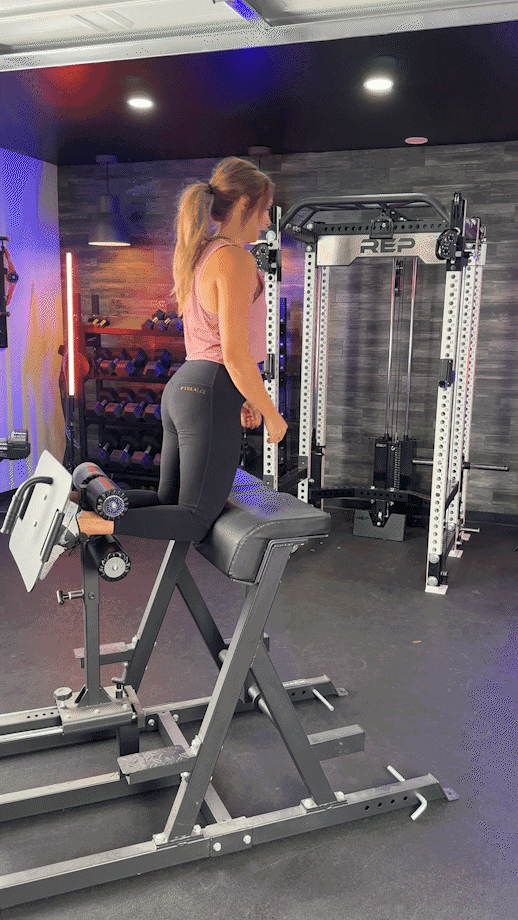
Modifications
- Dial it back: Try band-assisted GHRs by looping one end of a resistance band around the back of the machine and the other around your chest. Then, perform the exercise as normal until you can do the bodyweight version.
- Make it harder: Hold a weight plate to your chest to make it more difficult. Alternatively, wear a weighted vest. Or, instead of pausing momentarily at the bottom, add a longer hold.
RELATED: Best Glute Machines
Pendlay Row
Muscles worked: Latissimus dorsi, rhomboids, trapezius, posterior deltoids, hamstrings, lower back, glutes, biceps, core
Benefits: The Pendlay row has similar benefits to barbell bent-over rows, which you saw above. The main difference with Pendlay rows is that you’ll need to reduce the weight you lift. Although this sounds like a disadvantage, the advantage is that you’ll improve your explosive strength and power in the posterior chain because the bar stops after each rep.
How to Do it:
- Place a loaded barbell on the ground.
- Step underneath the bar with your feet shoulder-width apart, similar to how you would do a deadlift.
- Bend your knees slightly, then push your hips back so your chest moves toward the floor. Keep going until your torso is parallel to the ground.
- Grab the bar with an overhand grip (palms facing the floor). You’ll want your hands to be outside your legs, slightly wider than shoulder-width apart.
- Engage your core and lats, and pull the bar toward your abdominal region.
- Pause momentarily before returning the bar back to the ground.
- Continue for the desired number of reps.
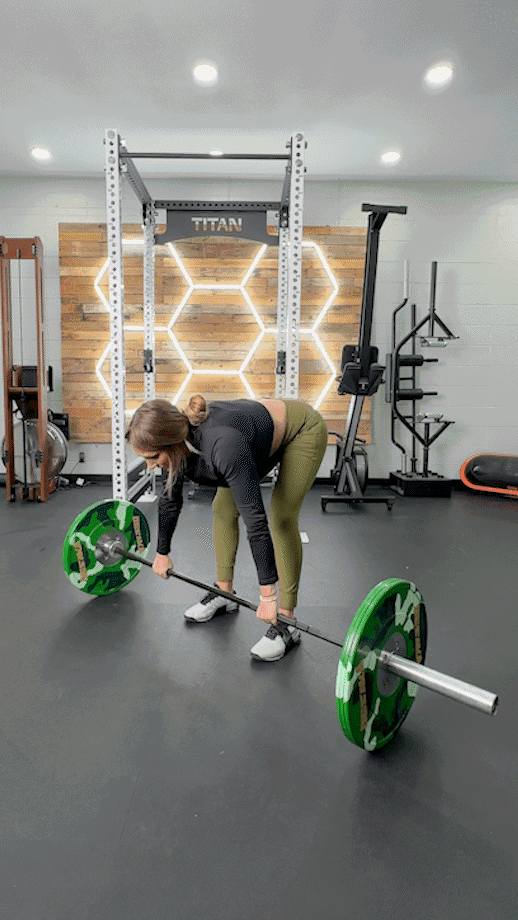
Modifications
- Dial it back: Instead of a barbell, use a pair of kettlebells to reduce the range of motion and place less stress on the wrists. This is because of the neutral grip position. You can also try single-arm Pendlay rows using one kettlebell.
- Make it harder: To increase your range of motion and maximize your muscles’ time under tension (TUT), perform this exercise standing on a raised platform or a weight plate. This variation is called a deficit Pendlay row.
Cable Pull-Through
Muscles worked: Glutes, hamstrings, lower back
Benefits: Working your posterior chain using a cable machine can be safer than barbells and dumbbells due to the fluidity of their movement. Cables are also more efficient because you can change your weight in seconds. Consistently doing the pull-through exercise may help strengthen your other posterior chain lifts.
How to Do it:
- Adjust the pulley on one side of a cable machine to its lowest position.
- Attach a rope attachment and select the required weight.
- Face away from the cables and grasp the rope between your legs with a neutral grip.
- Step forward a couple of steps until you feel the tension in your posterior chain muscles.
- Engage your core, keep your head neutral, and push your hips back until you feel a stretch in your hamstrings.
- Hold, then push through your feet and glutes to stand up.
- Keep going for reps.
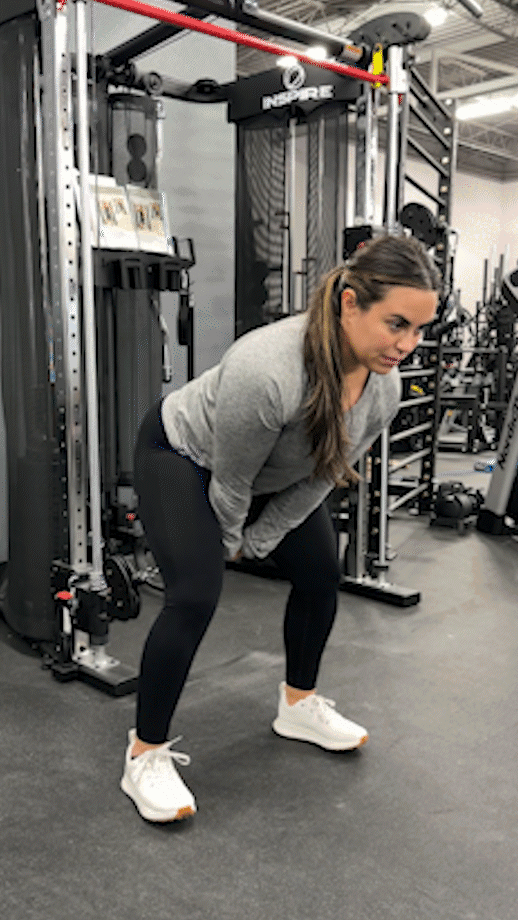
Overhead Carry
Muscles worked: Latissimus dorsi, rhomboids, trapezius, shoulders, hamstrings, lower back, glutes, triceps, core
Benefits: One of the main benefits of the overhead carry is that you work each side of the body separately, helping to fix muscular imbalances in the posterior chain. You’ll also address bilateral deficits4. It’s a simple exercise to learn and doesn’t require equipment other than a single kettlebell or dumbbell.
How to Do it:
- Grab a kettlebell or dumbbell with your left hand and press it overhead while standing. You’ll want your left arm to be straight without a bend in your elbow.
- Slowly walk forward in a straight line.
- Stop once you’ve reached the desired duration of time or distance.
- Repeat with your right hand.
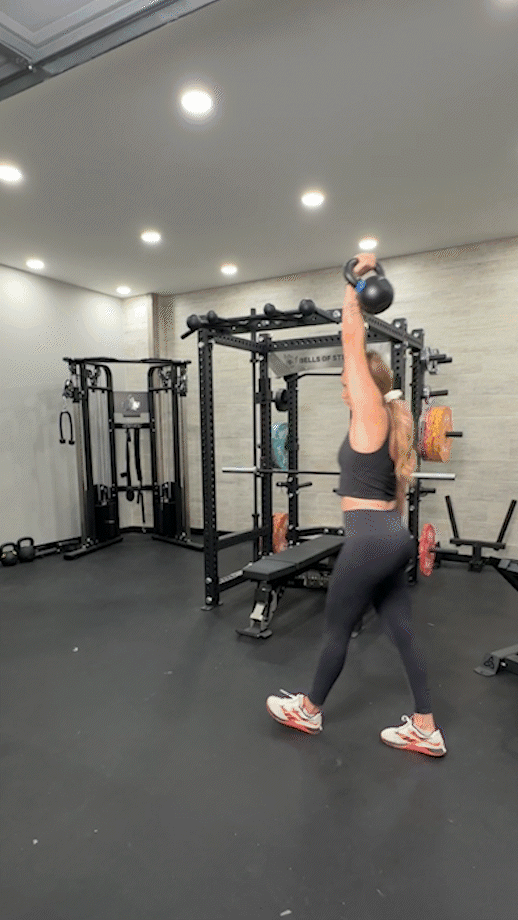
Modifications
- Dial it back: Use a lighter weight, or reduce the duration of time or distance.
- Make it harder: Even though you won’t benefit from unilateral training, try the barbell overhead carry to add more weight to the exercise. This can help improve your overhead press and Olympic lifts, such as clean and jerks.
Single-Leg RDL
Muscles worked: Hamstrings, lower back, glutes, core
Benefits: You get similar benefits to Romanian deadlifts (seen above), but there are differences. You’ll need to reduce your load, but can improve your balance, coordination, and stability. A 2023 study by Medicine and Science in Sports and Exercise5 found that you should include single-leg RDLs in hip-focused injury prevention or rehabilitation programs.
How to Do it:
- Stand upright with a dumbbell or kettlebell in your left hand.
- Extend your left arm and position it near your left quad.
- Bend your right knee and shift some of your body weight to your right-hand side.
- Lift your left foot off the floor slightly.
- Drive your right hip back so your chest and left arm move toward the ground. At the same time, lift your left leg toward the ceiling behind you.
- Stop when you can’t lower any further and pause.
- Begin lowering your left leg and push your right hip forward to return to the starting position.
- Continue for reps, then repeat the movement with your right hand.
RELATED: Best Kettlebells
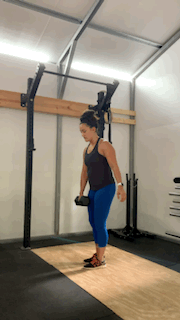
Modifications
- Dial it back: Switching from regular Romanian deadlifts (seen above) to single-leg RDLs can cause issues with balance and stability. Do split-stance Romanian deadlifts at first because both feet are on the ground throughout.
- Make it harder: Perform single-leg RDLs from a deficit instead of from the floor. Increasing your range of motion will mean the weight gets closer to your ankles rather than the middle of your shins.
Pull-Up
Muscles worked: Latissimus dorsi, rhomboids, trapezius, posterior deltoids, biceps, core
Benefits: Pull-ups are a great exercise to hit the back muscles of the posterior chain. You won’t work the lower body much, but it’s one of the best exercises for your upper body. Pull-ups only require your body weight, too, so you can do them practically anywhere.
How to Do it:
- Stand underneath one of the best pull-up bars.
- Hold the handles or bar with a wide, overhand grip (palms facing away from you).
- Lift your feet off the floor to enter the dead hang position.
- Activate your core, keep your chest up, and pull yourself toward the bar. The majority of the work should be done with your back muscles, not your biceps.
- Continue until your chin clears the bar, then pause.
- Lower yourself back to the dead hang position with control.
- Repeat for reps.
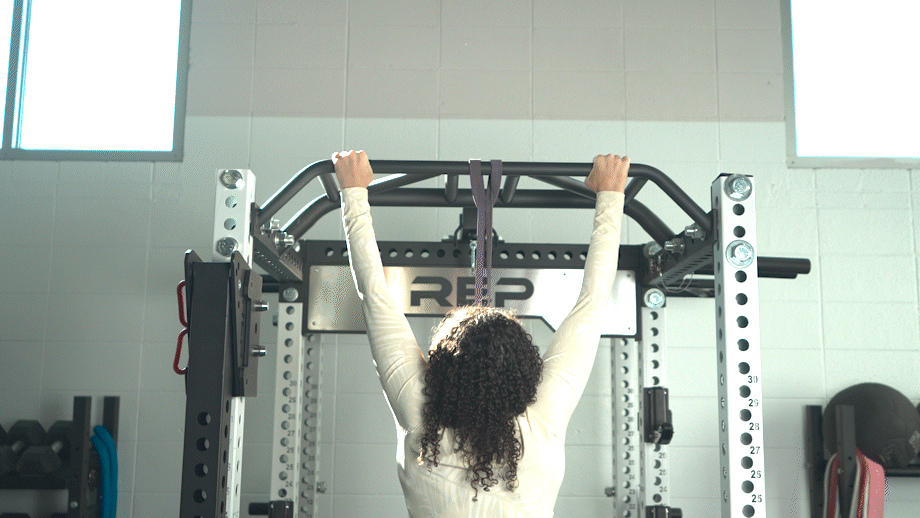
Modifications
- Dial it back: Inverted rows work the same muscles as pull-ups but are easier to do. I also recommend negative pull-ups to my clients. To perform a negative pull-up, only do the eccentric (or lowering) phase of the pull-up.
- Make it harder: Add extra weight to your pull-up using a dip belt or weighted vest. If you’re up for the challenge, attempt one-arm pull-ups (using a resistance band if needed!).
RELATED: Pull-up Progression Plan
Lunge
Muscles worked: Glutes, hamstrings, quads, core
Benefits: Lunges activate every lower-body posterior chain muscle group and require little to no equipment. I love how many variations there are, so everyone from beginners to more advanced gym-goers can benefit. They’re also a unilateral exercise, helping to fix strength and muscle imbalances.
How to Do it:
- Stand tall with your arms at your sides or both hands placed on your hips. Your feet should be hip-width apart.
- Tense your core, and step forward with your left leg.
- Bring your right knee toward the floor, bending your left knee at the same time.
- Keep lowering until your left thigh is almost parallel to the floor. Pause.
- Push through your left foot to stand up and step back.
- Now switch and step forward with your right leg.
- Lunge for reps, alternating sides each time.
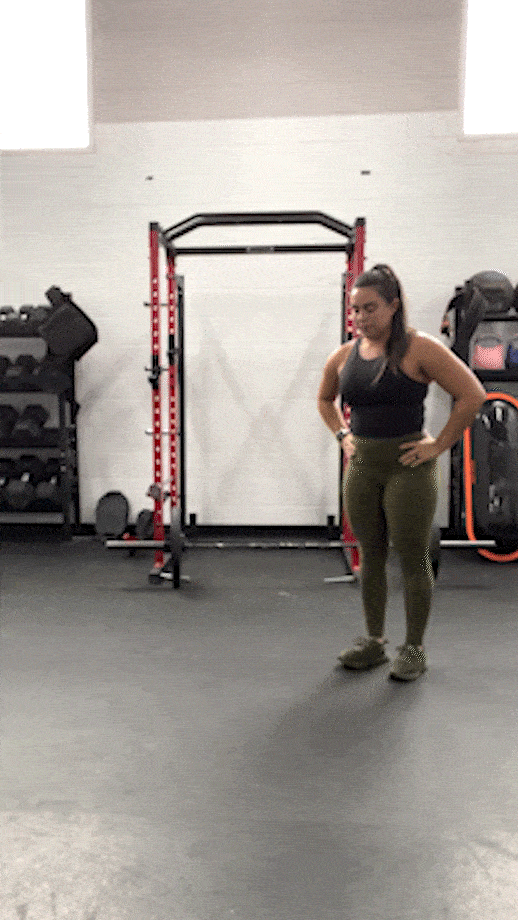
Modifications
- Dial it back: If you’re doing lunges for the first time, hold onto a squat rack or TRX suspension system to help stabilize yourself. You can also do half lunges where your back knee doesn’t go all the way to the ground.
- Make it harder: Progressions include reverse lunges, walking lunges, weighted lunges, lateral lunges, rear-leg-elevated lunges (aka Bulgarian split squats), jumping lunges, and more. Try out these variations to see what you enjoy.
Sample Posterior Chain Workouts
Now that I’ve shared the 13 best posterior chain exercises, you’re ready to include them in your programming. Here are three sample posterior chain workouts for beginners, for hypertrophy, and for strength that I would recommend to a client:
Posterior Chain Workout For Beginners
I’ve selected three posterior chain exercises for beginners—two for the lower body and one for the upper body. If bodyweight lunges feel too easy, consider a more challenging alternative (such as dumbbell lunges).
If you don’t have a barbell and weight plates or are uncomfortable with barbell training, replace barbell bent-over rows with dumbbells, kettlebells, or a resistance band.
To warm up, do a few minutes of cardio, then dynamic exercises such as arm circles and swings, jumping jacks, and bodyweight squats.
RELATED: Best Warm-Up Exercises
| Exercise | Sets | Reps |
| Bodyweight Lunge | 3 | 8 |
| Barbell Bent-Over Row | 4 | 10 |
| Cable Pull-Through | 3 | 12 |
Equipment needed: A barbell and weight plates or pair of dumbbells and a cable machine machine with a rope attachment or resistance band.
Posterior Chain Workout For Hypertrophy
To gain muscle (aka hypertrophy), we’ll increase the number of exercises and sets. Each set will be between six and 12 reps because this is the optimal number of reps to build muscle. If bodyweight pull-ups feel easy, wear a weighted vest or dip belt. Replace glute-ham raises with barbell hip thrusts if your gym doesn’t have a dedicated machine.
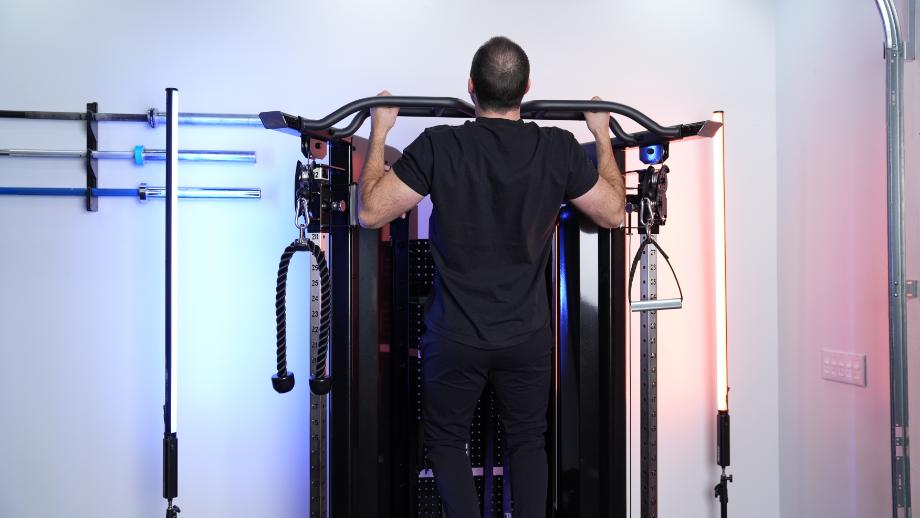
Do a few minutes of cardio and some dynamic exercises before you start. You’ll want to perform lighter sets of Romanian deadlifts and Pendlay rows before progressing to heavier weights.
| Exercise | Sets | Reps |
| Pull-Up | 3 | 6 |
| Romanian Deadlift | 4 | 8 |
| Pendlay Row | 4 | 10 |
| Glute-Ham Raise | 3 | 12 |
| Overhead Carry | 2 | 30 sec., each side |
Equipment needed: A pull-up bar, a barbell and weight plates or pair of dumbbells, a glute hamstring developer (GHD) machine, and a single kettlebell or dumbbell.
Posterior Chain Workout For Strength
This workout has four exercises to increase your posterior chain strength. Each set will be five reps, allowing you to lift heavier weights than you would with the hypertrophy workout above (around 85% to 90% of your one-rep max). You’ll need to rest for at least two minutes between sets—maybe even three—before moving on.
Perform a similar warm-up to what I’ve mentioned above. You’ll need to do more lighter sets before your working sets because you’ll be lifting heavier loads.
| Exercise | Sets | Reps |
| Rack Pull | 3 | 5 |
| Weighted Pull-Up | 3 | 5 |
| Barbell Hip Thrust | 3 | 5 |
| Barbell Bent-Over Row | 3 | 5 |
Equipment needed: A squat rack or power rack, a barbell and weight plates or pair of dumbbells, a pull-up bar, a weighted vest or dip belt, and a flat bench.
What Muscles Make Up Your Posterior Chain
Let’s go through posterior chain anatomy. When people think of the posterior chain, they usually think of the lower-body posterior chain muscles, such as the hamstrings and glutes, technically incorrect. Your posterior chain starts from your neck and goes to the back of your feet.
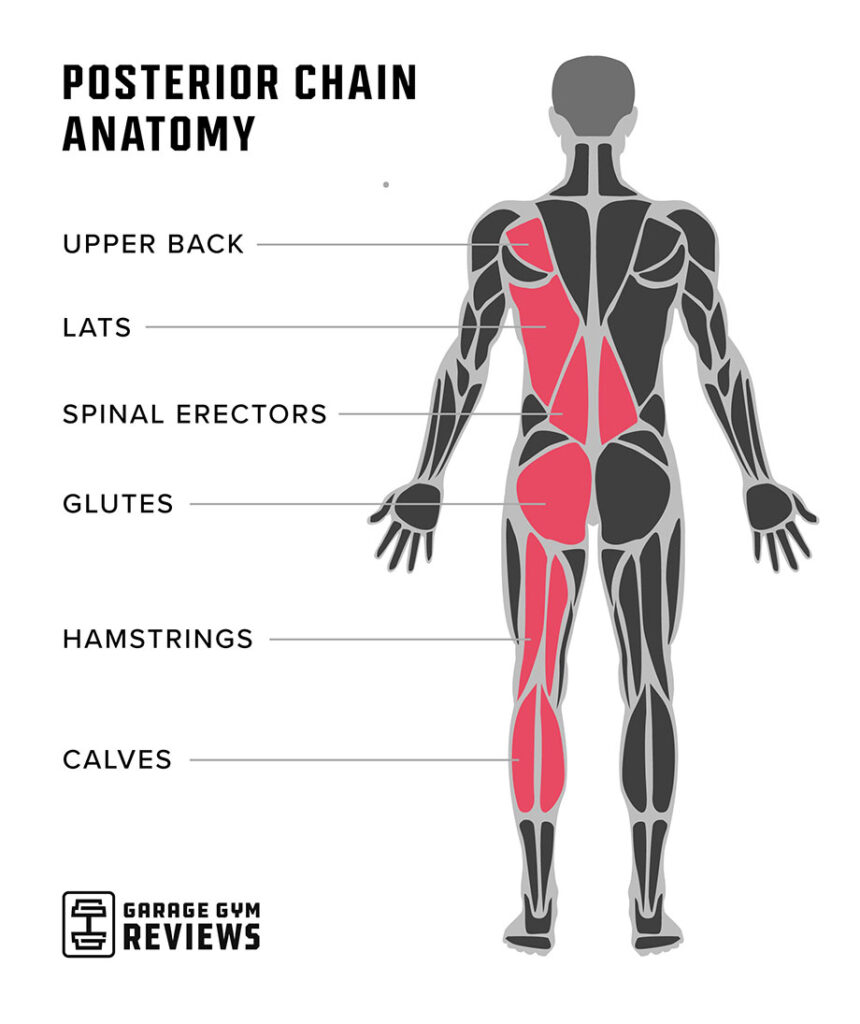
See below for the main muscles that make up the posterior chain:
- Latissimus Dorsi: The latissimus dorsi works collaboratively with the teres major and pectoralis major to adduct, medially rotate, and extend the arm at the glenohumeral joint6.
- Rhomboids: The rhomboids are important in upper limb movement and stability of both the shoulder girdle and scapula7.
- Trapezius: The trapezius is responsible for stabilizing and moving the scapula8.
- Posterior Deltoids: The posterior deltoid works with the latissimus dorsi to extend the arm during ambulation9 and helps to stabilize the arm throughout abduction.
- Hamstrings: The hamstrings play a prominent role in hip extension (posterior movement of the femur) and knee flexion (posterior movement of the tibia and fibula)10.
- Glutes: Three different muscles form the glutes—maximus, medius, and minimus—and collectively, their main actions are to extend and externally rotate the thigh11.
Benefits of Training the Posterior Chain
A strong posterior chain is aesthetically pleasing, can reduce lower back pain, and may improve anterior chain lifts. Allow me to elaborate:
It’s Aesthetically Pleasing
I’ve discussed posterior chain anatomy, and several muscle groups are involved. Doing posterior chain exercises can help build muscle and help you look (and feel) your best. For me, a thick and symmetrical back is one of the most impressive things about strength training, and robust hamstrings and glutes go a long way to developing a muscular lower body.
Helps Reduce Lower Back Pain
A 2017 Sports Medicine Open12 systematic review found that posterior chain exercises may help patients with chronic low back pain to maximize their improvements in pain, disability, and muscle strength. Even if this isn’t you right now, back pain is common for those with desk jobs. Reduced risk of injury is one reason to build strength in the backside of the body.
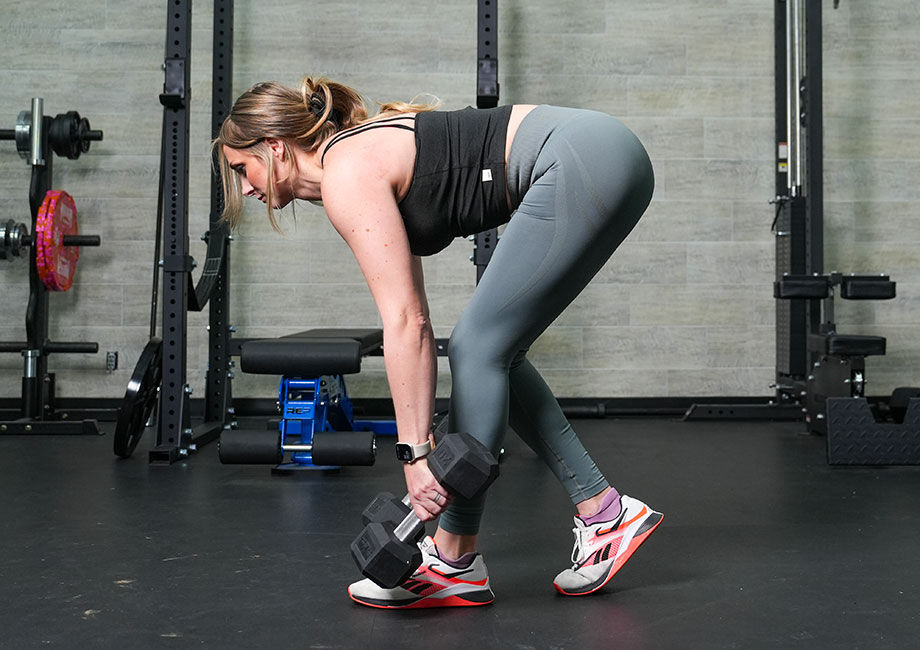
Helps Improve Anterior Chain Lifts
The opposite of the posterior chain is the anterior chain. The issue I find as a personal trainer is that everyone wants to do anterior chain exercises (think bench presses, planks, and back squats), and the posterior chain comes second. The truth is they’re equally important, and when you strengthen your posterior chain, you may improve your anterior chain lifts.
Posterior Chain Exercises: Final Thoughts
Your posterior chain makes up half of your body, so knowing the best posterior chain exercises (and how to do them correctly) is important. Adding these exercises to your regular program can help you build muscle, reduce lower back pain, and improve your anterior chain lifts. You’ll want a combination of upper and lower-body posterior chain exercises in your routine, but remember to do them with proper form to avoid injury.
Posterior Chain Exercises: FAQs
What happens when you have a weak posterior chain?
A weak posterior chain can lead to lower back pain or poor posture, affecting athletic performance in the gym or during sprinting. The average person spends more time sitting at a desk or in the car than ever before, so doing posterior chain exercises has become even more vital for overall wellness.
How can I make my posterior chain stronger?
To make your posterior chain stronger, try some or all of the following posterior chain exercises that I recommend to my personal training clients:
-Barbell bent-over row
-Romanian deadlift
-Good morning
-Barbell hip thrust
-Kettlebell swing
-Rack pull
-Glute-ham raise
-Pendlay row
-Cable pull-through
-Overhead carry
-Single-leg RDL
-Pull-up
-Lunge
Everyone’s different and will prefer different exercises. Once you find four or five that work for you, do them consistently to strengthen your posterior chain.
Do squats work the posterior chain?
Although back squats do work the posterior chain to some degree, they’re more of an anterior chain exercise. The primary muscle targeted during squats is the quads. You’ll also hit your glutes and hamstrings, but if you want to strengthen your posterior chain, try adding exercises to your workout routine that directly activate it.
References
- McAllister MJ, Hammond KG, Schilling BK, Ferreria LC, Reed JP, Weiss LW. Muscle activation during various hamstring exercises. J Strength Cond Res. 2014 Jun;28(6):1573-80. doi: 10.1519/JSC.0000000000000302. PMID: 24149748.
- Neto WK, Vieira TL, Gama EF. Barbell Hip Thrust, Muscular Activation and Performance: A Systematic Review. J Sports Sci Med. 2019 Jun 1;18(2):198-206. PMID: 31191088; PMCID: PMC6544005.
- Manocchia P, Spierer DK, Lufkin AK, Minichiello J, Castro J. Transference of kettlebell training to strength, power, and endurance. J Strength Cond Res. 2013 Feb;27(2):477-84. doi: 10.1519/JSC.0b013e31825770fe. PMID: 22549084.
- Škarabot J, Cronin N, Strojnik V, Avela J. Bilateral deficit in maximal force production. Eur J Appl Physiol. 2016 Dec;116(11-12):2057-2084. doi: 10.1007/s00421-016-3458-z. Epub 2016 Aug 31. PMID: 27582260.
- Collings TJ, Bourne MN, Barrett RS, Meinders E, GONçALVES BAM, Shield AJ, Diamond LE. Gluteal Muscle Forces during Hip-Focused Injury Prevention and Rehabilitation Exercises. Med Sci Sports Exerc. 2023 Apr 1;55(4):650-660. doi: 10.1249/MSS.0000000000003091. PMID: 36918403.
- Jeno SH, Varacallo M. Anatomy, Back, Latissimus Dorsi. [Updated 2023 Mar 5]. In: StatPearls [Internet]. Treasure Island (FL): StatPearls Publishing; 2024 Jan-. Available from: https://www.ncbi.nlm.nih.gov/books/NBK448120/
- Farrell C, Kiel J. Anatomy, Back, Rhomboid Muscles. [Updated 2023 May 16]. In: StatPearls [Internet]. Treasure Island (FL): StatPearls Publishing; 2024 Jan-. Available from: https://www.ncbi.nlm.nih.gov/books/NBK534856/
- Ourieff J, Scheckel B, Agarwal A. Anatomy, Back, Trapezius. [Updated 2023 Mar 11]. In: StatPearls [Internet]. Treasure Island (FL): StatPearls Publishing; 2024 Jan-. Available from: https://www.ncbi.nlm.nih.gov/books/NBK518994/
- Elzanie A, Varacallo M. Anatomy, Shoulder and Upper Limb, Deltoid Muscle. [Updated 2024 Jan 30]. In: StatPearls [Internet]. Treasure Island (FL): StatPearls Publishing; 2024 Jan-. Available from: https://www.ncbi.nlm.nih.gov/books/NBK537056/
- Rodgers CD, Raja A. Anatomy, Bony Pelvis and Lower Limb, Hamstring Muscle. [Updated 2023 Apr 1]. In: StatPearls [Internet]. Treasure Island (FL): StatPearls Publishing; 2024 Jan-. Available from: https://www.ncbi.nlm.nih.gov/books/NBK546688/
- Elzanie A, Borger J. Anatomy, Bony Pelvis and Lower Limb, Gluteus Maximus Muscle. [Updated 2023 Apr 1]. In: StatPearls [Internet]. Treasure Island (FL): StatPearls Publishing; 2024 Jan-. Available from: https://www.ncbi.nlm.nih.gov/books/NBK538193/
- Tataryn N, Simas V, Catterall T, Furness J, Keogh JWL. Posterior-Chain Resistance Training Compared to General Exercise and Walking Programmes for the Treatment of Chronic Low Back Pain in the General Population: A Systematic Review and Meta-Analysis. Sports Med Open. 2021 Mar 8;7(1):17. doi: 10.1186/s40798-021-00306-w. PMID: 33683497; PMCID: PMC7940464.
Further reading

Whether you want a supportive community or prefer to do things on your own, these are the best weight loss programs to help you reach your goals. Read more

Including posterior chain exercises in your workout routine is important for several reasons. A thick and well-developed back, as well as powerful glutes and hamstrings, are aesthetically pleasing. You may notice a reduction in lower back pain, especially if you’re a beginner to resistance training. As a result of increasing your posterior chain strength, your anterior chain lifts may improve.Based on my 10 years of experience in weight training—both as an enthusiast and a certified personal trainer—I’ve put together the 13 best posterior chain exercises. » Read more about: 13 Posterior Chain Exercises To Build Muscle and Reduce Lower Back Pain » Read more

What’s so cool about the shoes CrossFit Games athletes wore in 2023? Find out in our TYR CXT-1 training shoes review. Read more

Looking for an under-desk treadmill for your WFH office? Check out this WalkingPad review with our expert take after one year of use. Read more

